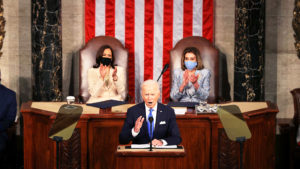In the late stages of the American Covid regime, “The Science” has become dramatically less important to the ruling class. Notably missing from a new debate about masking policy, in which President Biden has cast doubt on the recent decision by seven Democratic governors to lift their state’s mandates as “probably premature”, is any indication that either side had registered the mounting evidence that mask mandates have not worked.
“ICU Doctor here: I skied 4 hrs in an N95 + a ski mask on top of it! Did not get hypoxic or hypercapnic!” an anaesthesiologist named Ilad Sharifpour tweeted last month. The Centers for Disease Control (CDC) advises that “in general, people do not need to wear masks when outdoors”. But such is the enthusiasm for masking among some people, including medical professionals, that the doctor felt moved to boast about outdoing the CDC guideline while engaging in a solo sport that involves high-speed travel through wide-open spaces.
Last May, in a particularly striking example of the “permanent pandemic” mindset, two American doctors wrote an article arguing that masking should “remain with us, becoming part of our everyday lives even as the Covid-19 pandemic, science willing, subsides”. Yet that emotional attachment to masks is even more pronounced today, amid a backlash to the governors’ move and proposals to lift remaining mask requirements in public schools. The New York Times‘s Covid reporter David Leonhardt — a pro-vaccine, pro-masking moderate liberal — was denounced online by hundreds of people last week simply for pointing out that mask mandates involve tradeoffs.
It seems that for a certain group of pandemic diehards, the fact that the guidance on masking has been so overtly unreliable and politicised has actually made masks more, rather than less, potent as instruments of public policy. In less than two years, the CDC has changed its position on masks at least three times. The agency originally discouraged their use before endorsing it, before finally acknowledging the cloth masks used by most Americans cannot stop the fine aerosols that spread Covid — which is exactly what Dr. Anthony Fauci wrote in a private letter from February 2020.
Given that we now know that these public health decisions are not rooted in The Science, the crucial question remains: Why did tens of millions of people willingly give up their freedoms and embrace the ever-changing dictates of such transparently incompetent and undeserving authorities?
So far, two types of answers seem to hold the most explanatory power. The first focuses on the psychology behind the mass adoption of fear-based emergency measures. The second looks at material rather than psychological factors, using the formula favoured by Lenin: “Who, whom?” In other words, which groups have benefited from the Covid regime, and at whose cost?
The most compelling account of the “permanent pandemic” mindset, it seems to me, is one that recognises the confluence of these two forces. The Covid regime provided a grand life-or-death psychological drama that enlarged the power of the government and its partners in the tech industry, while enabling the destruction and economic displacement of small businesses that make up the base of the Republican party. Some 20% of small businesses and roughly 41% of black-owned small businesses in the US have been forced to close since the start of the pandemic. In the first year of the pandemic alone, there were an extra 200,000 business closures above historical levels. Hardest-hit, according to the Wall Street Journal, were: “Barber shops, nail salons and other providers of personal services.”
One popular psychological theory of the pandemic is ‘mass formation psychosis’, also known as mass formation hypnosis or, simply, mass formation. Developed by Mattias Desmet, a psychology professor at Ghent University in Belgium, it posits that the response to Covid in countries with strict policies illustrates how people can be brought into a collective trance that makes them easy to manipulate and prone to acting in ways that are contrary to reason and evidence.
Such mass formation can only occur, according to Desmet, when four conditions are met: the society has to be atomised and lacking in social bonds; most people living in it must feel a pervasive sense of meaninglessness about their own lives; they must also feel a free-floating anxiety that is not attached to any particular cause; finally, there must also be high levels of free-floating frustration and aggression that, again, have no specific source.
It’s plausible that these conditions were met in the United States when the pandemic broke out. A survey of 10,000 adult American workers taken between July and August 2019 found that three out of five reported being lonely, a 13% increase from the previous year. The number was even higher for heavy social media users, 73% of whom reported feeling lonely. Then came the pandemic, one year into which Americans reported having fewer close friends. In circumstances like these, Desmet argues, mass media can inculcate a narrative that provides the public with a fixed object for its ambient anxiety, drawing otherwise isolated individuals into a common cause in confronting the supposed menace.
The theory, with its obvious evocations of 20th-century totalitarian movements, was popularised when it was brought up on Joe Rogan’s podcast by Robert Malone, a scientist known for his warnings about the risks of mRNA vaccines. That interview may have been the beginning of the end for Rogan. Something about the mass formation hypothesis clearly struck a nerve with state authorities and information commissars and it was almost immediately censored and scrubbed from Google results. Desmet neither denies the existence of Covid nor attacks vaccines. He merely argues that the response to the pandemic has entailed a series of unscientific overreactions that have whipped the public into a dangerously susceptible state.
People disposed to strictly rational explanations of large-scale events will find Desmet’s mass psychology unconvincing, but much of what has happened over the past two years defies rational accounting. Why did certain drugs such as hydroxychloroquine and ivermectin become stigmatised as politically untouchable and subject to gross distortions in the press, with CNN calling ivermectin, a Nobel prize-winning drug that had previously been used to treat over 100 million people across the world for ailments like River Blindness, a “horse dewormer?” These kinds of hyper-polarised rituals resemble past collective frenzies and moral panics.
Yet there are obvious limits to what psychology can account for in the past two years. There’s no psychological phenomenon sufficient to explain why the pandemic has been so beneficial to financial capital or led to the technology industry making a record-setting $1.4 trillion in 2021. As Marketwatch put it in a recent headline: “Big Tech’s pandemic year produces mind-boggling financial results”.
It’s not simply that the rich have gotten richer, though that’s certainly true as America’s billionaires added $2.1 trillion to their net worth during the pandemic. It’s Silicon Valley corporations with close ties to the Democratic party, like Google, that have benefited most.
While the tech companies have few actual employees compared to older productive industries, their largesse now directly subsidises whole sectors of the professional class economy, including journalism. Individual professionals may not have become richer during the pandemic but, unlike hundreds of thousands of American workers who lost their jobs — many of whom worked in the small businesses that were shuttered over the past two years — their employment was mostly secure.
Perhaps it’s not surprising, then, that those professionals would instinctively internalise Covid policies that enriched their tech oligarch patrons as a personal victory and defence of their own status. Few would put it that way, of course. Instead, they accuse protesting truck drivers of being fascists and call for them to be arrested because they recognise that medical mandates provide a ruthlessly efficient — yet morally sanctioned — means for sorting the populations between rulers, who deserve to monopolise power, and subjects, who can follow the rules or be crushed. That seems to be the underlying logic animating Juliette Kayyem, a former homeland security official under Obama who spoke for many in her circles when she recommended the best way to deal with the protests: “Slash the tires, empty gas tanks, arrest the drivers, and move the trucks.”
Recently Toby Green and Thomas Fazi, both self-described Leftists, posed a series of questions about the Left’s relationship to Covid policies that had been devastating to the working class and global south. “Why has the mainstream Left ended up supporting practically all Covid measures?” they asked on UnHerd. And how, they wondered. did the Left end up ridiculing the very notion that there might be motivations from the vaccine manufacturers other than “the public good” at play?
The answer, it seems, is fairly clear: the Left did this because the Public Good has become, along with The Science, largely a costume worn by the professional classes who, quite rightly, suspect that they have more in common with a Moderna executive than an anti-vaccine mandate truck driver.
Disclaimer
Some of the posts we share are controversial and we do not necessarily agree with them in the whole extend. Sometimes we agree with the content or part of it but we do not agree with the narration or language. Nevertheless we find them somehow interesting, valuable and/or informative or we share them, because we strongly believe in freedom of speech, free press and journalism. We strongly encourage you to have a critical approach to all the content, do your own research and analysis to build your own opinion.
We would be glad to have your feedback.
Source: UnHerd Read the original article here: https://unherd.com





